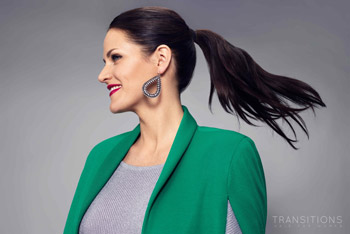Andrew Wilson Alopecia On The Rise Interview

Andrew Wilson Alopecia On The Rise Interview
A study by the International Society of Hair Restoration Surgery has revealed that hair loss is no longer the domain of men. The study identified that since 2004, the number of female patients increased by 24% worldwide, with women now making up 14.2% of all hair restoration patients.
Andrew Wilson, Hair Loss Consultant and Director of Transitions Hair says, 'In our studios across Australia we have seen a noticeable increase in the number of clients presenting with Alopecia, especially in women. They are also presenting at a younger age, year on year."
Alopecia is the medical term for hair loss in general. However, there are a number of different types of alopecia, with the most commonly presented forms in Australia being Alopecia Areata, Androgentic Alopecia and Traction Alopecia.
Andrew Wilson explains the differences:
Alopecia Areata: An autoimmune condition, which presents as patchy hair loss. This type of Alopecia can result in a single bald patch or extensive patchy hair loss.
Androgenetic Alopecia: This is also known as female pattern hair loss and can be seen in both men and women. It is a thinning of the hair to an almost transparent state, and is thought to be a hereditary form of hair loss.
Traction Alopecia This is usually caused due to excessive tension or pulling on the hair shafts, as a result of certain hair styles such as tight pony tails and buns. It is seen more often in women and the degree of hair loss can vary. Prolonged traction alopecia can stop new hair follicles developing and lead to permanent hair loss.
'More and more I'm seeing our female clientele present with traction alopecia due to prolonged use of clip‐in and beaded hair extensions, that pull on already fine hair. Our crown extensions are purposely designed to preserve and protect the hair you have," said Andrew.
Transitions Hair provides a variety of options for female hair loss with the most popular being their Crown Extensions. Each Crown Extension is handmade using only the highest quality hair available, often sourced from eastern European countries famous for the softness and beauty of their hair.
'Our Crown Extensions are ordered according to each clients measurements and are fitted and styled by our expert team. They are designed to be either easily clipped in, which takes less than a minute, or they can be permanently bonded and attached so they are just like your own hair. They look beautiful and are undetectable.
'Although they start at around the $2000 mark, a lot of clients don't realise that there is a rebate available for those under the age of 18, via variety, the Alopecia Foundation and in some situations government funding is available," said Andrew.
Transitions Hair offers women up-to-the‐minute options and the latest technology for hair loss or thinning hair. Free, private studio consultations are available on request in Sydney, Adelaide and Melbourne with accredited consultants.
Transitions Hair website at www.transitionshairforwomen.com.au or by calling 1300 427 778.
Interview with Andrew Wilson
Question: Are you surprised that the number of female hair loss patients has increased by 24% worldwide?
Andrew Wilson: No I'm not surprised. In our international group we have seen numbers of female enquiries increasing for many years. It is a global trend.
Question: Why do you believe this figure has significantly increased?
Andrew Wilson: I believe it has increased for the following reasons:
1. The internet - We all know of the "Dr. Google" phenomenon where people self diagnose, this easy access to information has helped women research their concerns in a broad sense, and specifically, their hair loss concerns in privacy and discretion. Previously, they would have to make a phone call with little information about what was available and what might be happening to them, this often left them feeling too embarrassed to get more information or even make the first call. Google has changed this. Today, a person can find out quality information about their hair situation and a range of possible solutions. This process of self education gives them the confidence to make the first call to a company that has a solution which is suitable for them.
2. Hereditary factors - Female pattern thinning has always occurred, in previous generations it might have been a mild level of thinning, but with every new generation the condition can become worse and begin earlier. Previously we would have seen women in their fifties visiting our studio, today it is women in their mid twenties.
3. The Contraceptive Pill - Is a known cause of female hair loss. At a societal level, with girls starting contraception at a younger age and more women using it these can conspire to trigger hair thinning in women. The pill adjusts a woman's natural hormone level and hair loss is often hormonally driven, depending on a woman's sensitivity to these changes will determine if her hair is affected. We often find that when women come off the pill or change contraceptive, it can destabilise the hormone balance and trigger the female pattern thinning process.
4. Stress - In an era of high achievement in all areas of life, we put much greater stress on our lives than previous generations. We aspire to more, achieve more, relocate more often and work harder than before. These all contribute to our stress levels. The body reacts in many ways to stress; some break out in rashes, others lose sleep, some go prematurely grey, others unfortunately lose hair. Often it recovers, but we are seeing an increased incidence where it doesn't recover.
Question: Is there a reason for the increase in the number of female clients presenting with alopecia?
Andrew Wilson: The question above relates to Androgenic Alopecia which is the area that we have seen the significant rise and represents about 80% of all female hair loss. This is hormonally driven hair loss, it is where the testosterone is converted to dihydrotestosterone (DHT). This DHT shrinks the hair follicles (both in length of life cycle, denier and length of hair) and eventually kills them off.
It doesn't refer to Alopecia Areate/ Totalis /Universalis, which is an auto immune condition. This form affects about 4% of the population to varying degrees.
Question: What is alopecia?
Andrew Wilson: Alopecia is the medical term for hair loss. There are two broad categories:
Androgenic or Androgenetic Alopecia - a hormonally and hereditary induced form of hair loss. It results in thinning of the hair, both in the denier (texture or quality change - a normal hair becomes fine or even baby fine in texture), length of life cycle and length the hair can grow.
Alopecia Areata (a catch all term)/ Alopecia Totalis / Alopecia Universalis - is an auto immune condition, hair follicles are attacked by the immune system . This form affects about 4% of the population to varying degrees. It can result in small patches of hair loss or total hair loss all over the body.
Question: Can alopecia be treated?
Andrew Wilson: Androgenic Alopecia can be treated in the initial phase with pharmaceutical medication. The most common one is an over the counter drug called Minoxidil (5%) which is applied to the scalp daily, it has been proven to be effective in 80% of people to regrow hair. The degree of regrowth varies from person to person. Other drugs such as Aldactone or Spironolactone and even an oral form of Minoxidil are often recommended for for women, these need a doctors prescription. Finally, Laser hair therapy is a proven, gentle and safe treatment for hair loss. Recent studies show that women can experience up to 51% hair growth from their current hair count (individual results vary).
Alopecia Areata - the best treatment is in the early stage of hair loss when small patches form. Steroidal creams are often used. Studies show that if cortisone is injected into the patches early on you will have a 50% increased chance of regrowing your hair. There are other drugs in clinical trials at the moment in Australia and the USA that look promising, but the outcomes of those trials will be many years away.
Question: Does the treatment of Alopecia depend on the type of Alopecia a client has?
Andrew Wilson: Yes. As the cause of the alopecia is different, so is the treatment used.
Question: How are hair extensions causing Alopeica in female clients?
Andrew Wilson: Hair extensions put added and unnatural weight on a persons hair. This weight can cause breakage and pull the hair out at the roots. With overuse, the hair extensions can cause -traction alopecia' through constant pulling on the hair, even if only via gravity. Long term use can cause permanent damage resulting in finer thinner hair and in extreme cases, permanent hair loss.
Question: How does Crown Extension work?
Andrew Wilson: Crown Extensions are designed to help women with Androgenetic Alopecia and hair thinning on the top, front and crown of their head. The Crown Extensions recreate the natural appearance of hair growing from your scalp, giving you more confidence. This is achieved through the use of a special transparent lace matrix. Individual natural hairs are implanted one strand at a time into this matrix, replicating the appearance and density of natural hair. The cosmetic result is hair growing from your scalp, natural and undetectable.
Contoured to the shape and size of the scalp where hair thinning is occurring, we always aim to strike the right balance- to use as much of your own growing hair as possible, whilst only adding additional hair where required. We ensure there is not too little, or too much hair, replicating the way your hair used to look.
Question: What other options does Transitions Hair provide?
Andrew Wilson: We provide a range of solutions, these range from Laser Hair treatment (we sell hair laser devices a person can use in the comfort of their own home), Cosmetic hair thickening products to create the appearance of thicker hair instantly (e.g. Biothik Hair Fibres), Hair tranplants and also high end wigs (for extreme cases of Alopecia and hair thinning).
Interview by Brooke Hunter
Have You Seen This?
MORE






